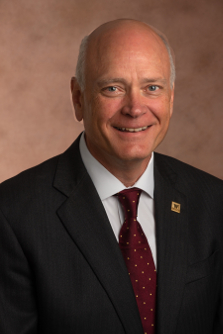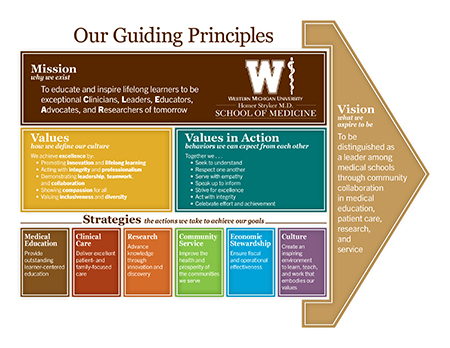
In his role as the founding dean, Dr. Hal B. Jenson says the vision he and other leaders have set for WMed – the aspiration for the institution to be distinguished as a leader among medical schools through community collaboration in medical education, patient care, research, and service – is an important gauge for success and something he carries with him daily.
Dr. Jenson says the work to fully achieve that important vision continues, but he also acknowledges that much has already been accomplished since his arrival at WMed eight years ago to establish the medical school as a key community partner in Southwest Michigan and other parts of the state.
“We have distinguished ourselves as an institution in the way that we’ve set out to accomplish our vision through intentional engagement with the community, and recognizing that we’re not sitting in an ivory tower,” Dr. Jenson said.
Dr. Jenson points to several tangible examples of ongoing community engagement and initiatives that are a reflection of the medical school’s vision and the striving to achieve that vision.
Among them are the work by:
- Dr. William Fales, professor in the department of Emergency Medicine, in his role as medical director for the Michigan Department of Health and Human Services Bureau of EMS, Trauma and Preparedness.
- Dr. William Nettleton, assistant professor in the department of Family and Community Medicine, who serves as the medical director for Kalamazoo County Health and Community Services and the Calhoun County Public Health Department. In those roles, Dr. Nettleton works closely with local governments and state agencies on PFAS contamination response and the opioid epidemic.
- Faculty in the department of Pathology provide medical examiner services for 12 counties in Michigan to support their county health departments and law enforcement. The Office of the Medical Examiner and Forensic Services includes six forensic pathologists, meeting the needs of the region.
 Moreover, Dr. Jenson said he is excited about the renovation of an unfinished portion of the seventh floor of the W.E. Upjohn M.D. Campus that is expected to be completed this fall. The work, which is funded by a substantial and generous grant from the Irving S. Gilmore Foundation, will bring department of Pathology faculty, staff, laboratories, and resources together on the seventh floor. This is intended to facilitate the medical school better meet the forensic pathology needs for the region.
Moreover, Dr. Jenson said he is excited about the renovation of an unfinished portion of the seventh floor of the W.E. Upjohn M.D. Campus that is expected to be completed this fall. The work, which is funded by a substantial and generous grant from the Irving S. Gilmore Foundation, will bring department of Pathology faculty, staff, laboratories, and resources together on the seventh floor. This is intended to facilitate the medical school better meet the forensic pathology needs for the region.
Dr. Jenson said the build-out of the seventh floor will improve efficiency, address current space constraints, and provide room for the growth of more anatomy education, resident and fellow training, and research.
“Eight years ago, none of this was here,” Dr. Jenson said. “We’ve grown with intentionality and hard work. And, we’ve grown with the goal of being integrated with the community and its needs.
“We’ve grown, and outgrown the space we had initially at the W.E. Upjohn M.D. Campus. We are grateful to the Gilmore foundation for the ability to better meet the needs of the community and our learners,” Dr. Jenson added. “The work on the seventh floor will not only improve efficiency for the department of Pathology, but their consolidation on the seventh floor also allows us to grow other departments at the medical school including Biomedical Informatics and our program in Medical Ethics, Humanities, and Law.”
